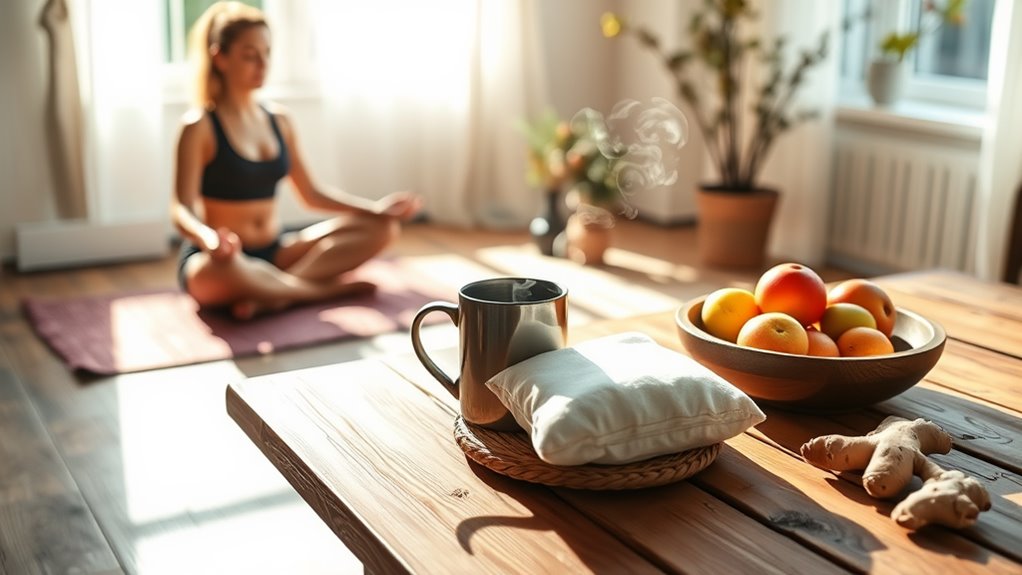Natural Period Relief- 4 Methods to Try Now
You can ease your period cramps naturally with these four effective methods. First, try herbal remedies like ginger to reduce inflammation or chamomile to relax muscles. Next, incorporate exercise, such as yoga poses or brisk walking, to boost endorphins and improve blood flow. Adjust your diet by adding omega-3-rich foods and magnesium sources to balance hormones and ease tension. Finally, apply heat with pads or warm baths for instant relief. You’ll uncover tailored strategies ahead to enhance these approaches.
Key Takeaways
- Ginger tea reduces inflammation and eases cramps, offering natural relief.
- Yoga poses like child’s pose stretch the abdomen and reduce muscle tension.
- Omega-3 foods, such as flaxseeds, lower prostaglandin levels to minimize discomfort.
- Apply a heating pad to the abdomen for 15-20 minutes to improve blood flow.
- Combine herbal remedies and exercise for a comprehensive approach to relief.
Herbal Remedies for Relief
Have you ever considered how simple herbs can ease period cramps? Ginger tops the list of effective period pain solutions, with studies showing it reduces inflammation and prostaglandin levels, offering relief comparable to ibuprofen. For enhanced relief, consider combining chamomile, ginger, and peppermint for a potent infusion.
Chamomile tea, another natural option, promotes muscle relaxation and eases discomfort through its antispasmodic properties. Peppermint, rich in menthol, soothes uterine contractions, while cramp bark targets spasms directly.
Incorporate these into your routine by brewing teas or taking supplements, backed by evidence from clinical trials. Always consult a healthcare provider before use to ensure safety and efficacy. Additionally, nettle, rich in iron, can help reduce menstrual flow and support overall menstrual health.
Exercise and Stretching Techniques
While period cramps can disrupt your daily routine, engaging in regular exercise and stretching offers a proven way to alleviate them by boosting endorphins and reducing muscle tension.
For example, you can try yoga poses like downward dog or child’s pose to gently stretch your lower back and abdomen, easing discomfort based on studies from the Journal of Obstetrics and Gynaecology.
Incorporate light cardio, such as brisk walking or cycling for 20-30 minutes daily, which research confirms enhances blood flow and minimizes cramp intensity.
Always start slowly; you’ll build endurance and feel the benefits quickly. Consistency matters—aim for routine practice to maximize relief.
Dietary Changes to Ease Discomfort
Adjusting your diet plays a key role in reducing period cramps by targeting inflammation and supporting hormonal balance. Including healthy fats from sources like avocados and olive oil can further support hormonal balance and minimize heavy period pain.
You’ll benefit from incorporating omega-3-rich foods like salmon and flaxseeds, which studies link to lower prostaglandin levels. Increase intake of fruits, vegetables, and whole grains for fiber and antioxidants that combat inflammation.
Limit processed foods, caffeine, and sugars, as research indicates they exacerbate discomfort. Add magnesium sources like nuts and leafy greens to ease muscle tension, and prioritize hydration to maintain electrolyte balance and reduce bloating.
These changes promote overall menstrual health. Furthermore, boosting your intake of vitamin C from fruits like oranges and strawberries can enhance iron absorption, helping to combat fatigue.
Heat Application Methods
Applying heat to your lower abdomen effectively eases period cramps by relaxing muscles and boosting blood flow. Research confirms this evidence-based approach reduces pain and inflammation quickly, offering a simple, natural solution you can integrate into your routine.
-
Use a heating pad: Place it on your abdomen for 15-20 minutes to target cramps directly, as studies show it improves blood circulation.
-
Try a hot water bottle: Fill it with warm water and apply gently; it’s a cost-effective way to soothe spasms.
-
Take a warm bath: Soak for 20 minutes to relax your whole body, backed by evidence of enhanced muscle relief.
-
Apply heat packs: Opt for microwavable versions for portable use, helping maintain consistent warmth.
-
Incorporate heated blankets: Wrap up for extended periods, as this method supports ongoing comfort per clinical findings.

